I once bought a lat pulldown machine that looked great in photos. It arrived, and… no one used it.
Too bulky. Not versatile. Total waste.
That mistake cost me money and space. Since then, I’ve learned which machines really work for gym owners and which don’t.
If you’re looking for the right kind of lat pulldown machine, you’re in the right place.
This article will show you 10 different types. I’ll explain what they do, who they’re for, and what to watch out for.
By the end, you’ll know what each type does—and which ones your gym actually needs.
Let’s dive in!
Table of Contents
- Comparison Table
- 1. Plate-Loaded Lat Pulldown Machines
- 2. Selectorized Lat Pulldown Machines
- 3. Low Row Machine
- 4. Dual Pulley System
- 5. Assisted Lat Pulldown
- 6. Functional Trainers
- 7. Smith Machine Lat Pulldowns
- 8. Smith Machine Upright Row
- 9. Wall-Mounted Lat Pulldown Machines
- 10. LAT Pull Down Machine Low Row
- Conclusion
Comparison Table
Not sure where to start? This table gives you a glimpse of the key specs and features across all 10 lat pulldown machines we’ll cover.
Machine Type | Weight System | Size (Approx.) | Key Features | Best For |
Plate-Loaded | Plate-loaded | 48” x 72” | Dual pegs, wide-grip bar, optional low row | Budget gyms, lifters who want control |
Selectorized | Built-in weight stack | 48” x 60” | Fast adjustments, labeled guides, quiet pulleys | High-traffic gyms, beginners |
Low Row Machine | Selectorized or plates | 48” x 60”–65” | Mid-back focus, angled footplate, compact frame | Full back stations, variety seekers |
Dual Pulley System | Dual stacks (150–200 lbs) | 60”–70” wide, 80” tall | Versatile angles, space-saving, functional training | Trainers, rehab, small studios |
Assisted Lat Pulldown | Built-in weight stack | 60” x 75” | Assisted pull-ups, multiple grips, compact footprint | Rehab clients, beginners, older adults |
Functional Trainer | Dual stacks (150–200 lbs) | 60”–65” wide, 80”+ tall | 50+ exercises, smooth cables, built-in storage hooks | All-in-one training spaces |
Smith Machine Lat Pulldown | Plate-loaded | 85” tall, 80” wide | High pulley add-on, barbell function, no extra frame | Small gyms with Smith machines |
Smith Machine Upright Row | Plate-loaded | 80” x 80” | Safe guided path, adjustable height, progressive overload | Controlled shoulder work, newer lifters |
Wall-Mounted Lat Pulldown | Plate or selectorized | 24”–30” wide, 80”+ tall | Wall-mounted setup, optional seat, clean and minimal layout | Small spaces, PT rooms, home gyms |
Lat Pulldown + Low Row Combo | Plate or selectorized | 48” x 70” | Dual function, stable build, easy high/low pulley transition | Multi-use training, space-saving setups |
You’ve got the summary. Now let’s get into the specifics of each machine—what they do, how they feel, and who they’re best for.
1. Plate-Loaded Lat Pulldown Machines
The first lat pulldown I ever bought for my gym was plate-loaded.
It wasn’t fancy. No buttons. No pin stacks. Just a bar and a place to load the weight manually.
But you know what? It worked like a charm.
These machines use weight plates—either standard 1-inch or Olympic 2-inch—to create resistance. You slide the plates onto the pegs. That’s it. No electronics. No selector pins to jam. Just solid lifting.
Specifications
Most plate-loaded machines include:
- Weight capacity: 300 to 600 lbs
- Frame: Heavy-duty 11-gauge steel
- Finish: Scratch-resistant powder coating
- Seat: Adjustable height with thick padding
- Thigh Pads: Locking design to keep you stable during heavy pulls
- Pulleys: High-quality nylon or aluminum
- Cable System: Aircraft-grade cable for smooth motion
- Footprint: Around 48” x 72” (compact enough for small gyms)
- Weight Horns: Fits standard or Olympic plates (adapters often included)
Features
- Dual Loading Pegs: Load plates on each side for balanced resistance. It keeps the pulling motion smooth and stable.
- Wide-Grip Lat Bar: Most machines include a 48” or longer bar, helping you fully engage your lats and upper back.
- Adjustable Thigh Pads: Keeps your legs locked in place during workouts. This helps you stay grounded when pulling heavier loads.
- Cable and Pulley System: Uses a high-tension cable that moves freely over the pulleys. You’ll feel consistent resistance through the full range of motion.
- Low Row Footplate (optional): Some models come with a footplate attachment. It lets you switch to seated rows without changing machines.
- Compact Frame: Designed to fit smaller spaces like garage gyms or tight commercial setups.
Is This Worth the Investment?
For gym owners who already stock Olympic plates, this machine adds value without extra overhead.
You get:
- Fewer service calls
- Flexible resistance control
- High equipment lifespan
However, manual weight changes can slow down turnover during peak hours, which may affect flow in high-traffic gyms.
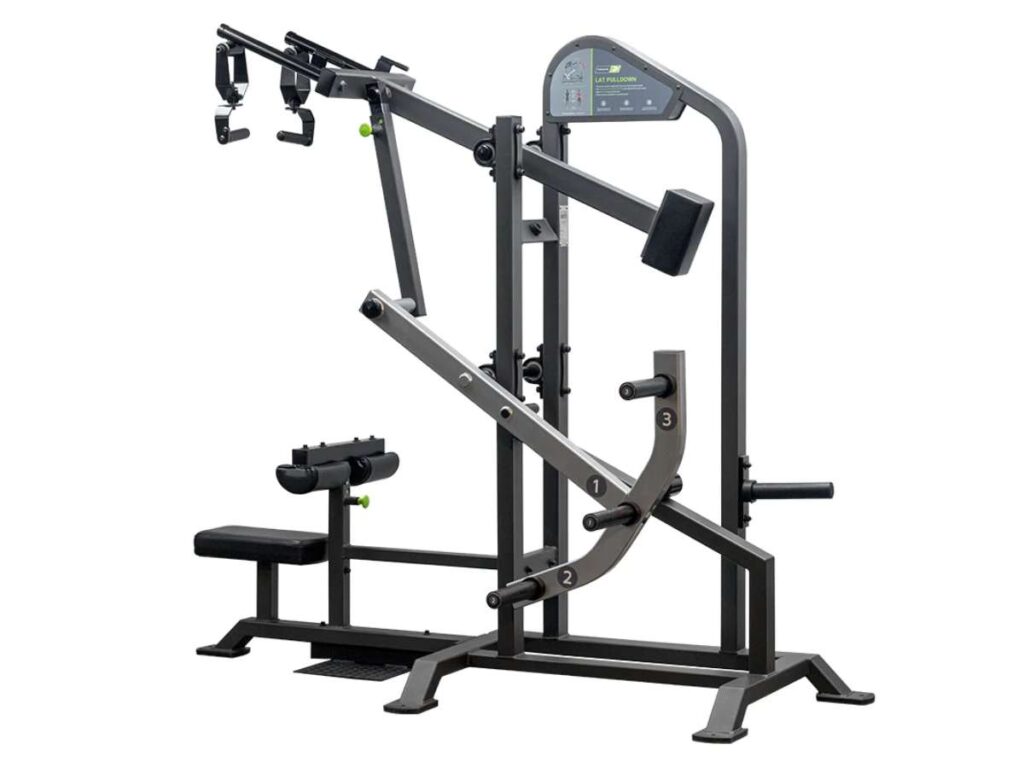
2. Selectorized Lat Pulldown Machines
When I upgraded my first training studio, a selectorized lat pulldown was the second machine I brought in. It instantly became one of the most-used pieces on the floor.
Why? Because it’s quick, simple, and beginner-friendly.
Unlike plate-loaded models, this one has a built-in weight stack. All the user has to do is pull a pin to change the resistance. No plates. No clutter. No wasted time. If you run a gym where people need speed and ease, this machine just works.
Specifications
Most commercial selectorized units offer:
- Weight Stack: 150–300 lbs (10–15 lb increments)
- Frame: Welded steel, powder-coated
- Pulley system: Nylon or aluminum with sealed bearings
- Seat: Adjustable with high-density foam
- Thigh pads: Adjustable with easy lock-in pin
- Footprint: Roughly 48” x 60” (space-saving)
- Total weight: Typically 400–600 lbs for stability
Features
- Built-in Weight Stack: Users select resistance by inserting a pin into the desired weight, making adjustments fast and straightforward.
- Consistent Resistance: Cable tension remains smooth and even, which helps maintain form and reduces strain during use.
- Compact Design: With everything built-in, there’s no need for extra weight plates or floor space.
- User-Friendly Labels: Most units have diagrams showing correct form and muscle groups targeted, which helps new members feel more confident. At YR Fitness, our equipment is user-friendly, clearly labeled, and designed to support both beginners and experienced users right out of the box.
- Quiet Pulley System: Pulley movement is smooth and quiet, offering a better training experience, especially in high-traffic gyms.
Is This Worth the Investment?
If your facility serves a large number of clients or group training, this machine adds serious value.
You’ll get:
- Faster client turnover
- Less need for staff instruction
- Fewer adjustments between users
However, the fixed weight stack may not satisfy advanced members seeking heavier resistance, limiting its appeal to power users.
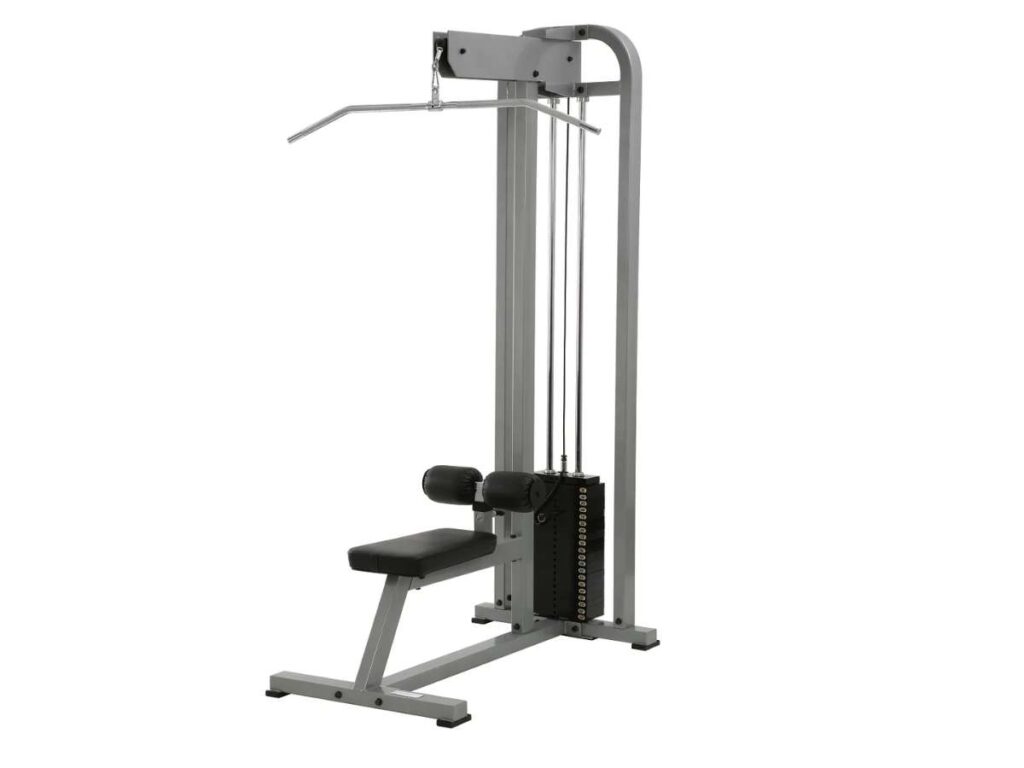
3. Low Row Machine
There was a time I thought a lat pulldown alone was enough for back training in my gym. Then I added a low row machine. That changed everything.
A low row machine works your mid-back, rhomboids, and rear delts. Unlike lat pulldowns that pull down vertically, this one lets users pull horizontally while seated. For gym owners trying to create a well-rounded back station, this piece fills the gap between lat work and full rows.
Specifications
Most low row machines offer:
- Weight Stack: 150 to 250 lbs (selectorized models)
- Frame: Solid steel with non-slip feet
- Handles: Dual grip or adjustable
- Seat: Padded, adjustable height
- Footplate: Angled for proper pulling posture
- Cable/pulley: Nylon or aluminum with sealed bearings
- Dimensions: Usually 48” x 60” to 65”
Features
- Horizontal Pull Motion: Trains the mid-back muscles, which complements vertical pulling from lat pulldowns.
- Selectorized or Plate-Loaded Options: Lets you pick what suits your gym best—faster weight changes or more max load.
- Angled Footplate: Helps users brace during heavy pulls, improving form and control.
- Neutral and Wide Grip Handles: Offers multiple grip positions for training variety and comfort.
- Compact Frame: Doesn’t take up much floor space while still offering solid functionality.
Is This Worth the Investment?
If you’re building a full back zone in your gym, this machine belongs there.
You’ll get:
- More training variety
- Better balance across upper back muscles
- A member-friendly design that’s easy to use
I’ve seen clients go from skipping back day to lining up for the low row. It makes that much difference.
However, some units cap out at moderate resistance, which might underdeliver for serious lifters or strength-focused clientele.
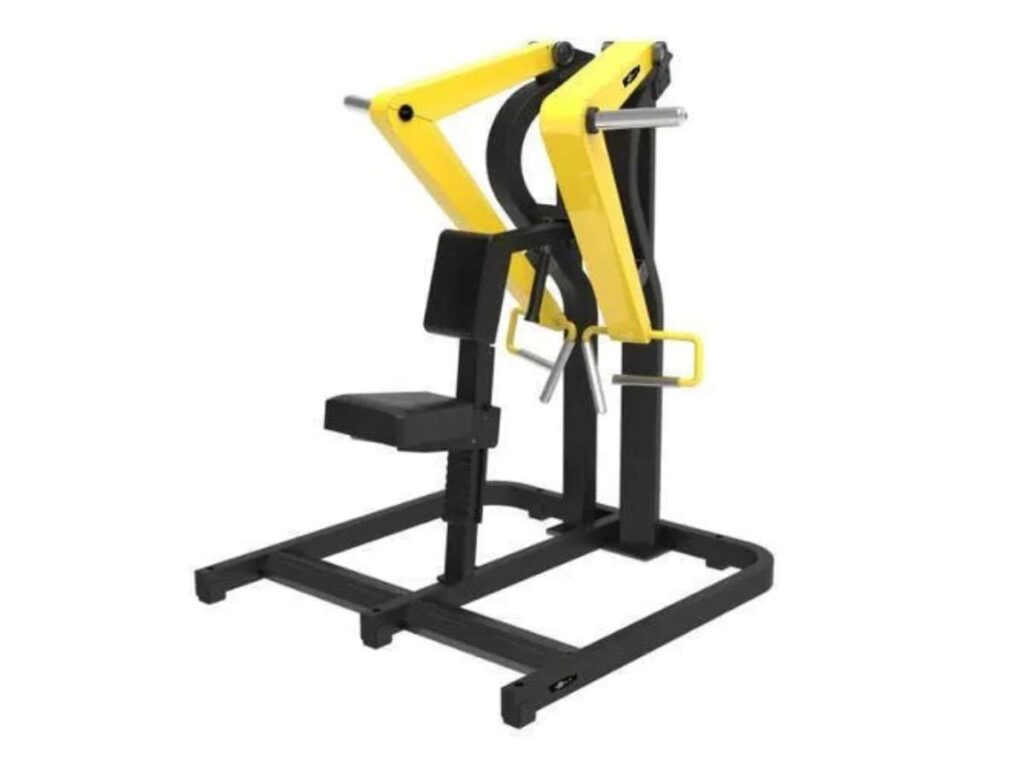
4. Dual Pulley System
Some machines earn their space. The dual pulley system is one of them.
A dual pulley system uses two adjustable arms, each with its own cable. Users can pull from almost any height or angle. That kind of freedom makes it valuable—especially in gyms with limited space.
Specifications
Typical setups offer:
- Pulley Range: Height-adjustable on both sides
- Weight Stack: Usually 150–200 lbs per side
- Handles: Standard D-handles (extra attachments optional)
- Frame: Steel tubing with wide base
- Dimensions: Around 60”–70” wide, 80” tall
- Cable System: Smooth glide with high-tension cables
Features
- Independent Dual Cables: Users can isolate each arm or train both, improving balance and stability.
- Adjustable Pulley Height: Allows vertical, diagonal, or horizontal movements for a full range of exercises.
- Wide Range of Exercises: Great for pulldowns, rows, curls, chest flies, triceps, and more.
- Space-Saving Design: Combines multiple machine functions into one footprint.
- Beginner-Friendly Setup: Clear diagrams and easy-to-move parts make it accessible for all levels.
Is This Worth the Investment?
If you need versatility without adding five new machines, this is a smart choice.
You’ll benefit from:
- More usage from a single unit
- Better return on floor space
- Less machine crowding in high-traffic areas
In many gyms, this becomes the go-to machine for trainers and clients alike. But please take note that the freedom of movement may overwhelm new members without proper instruction, requiring more trainer oversight.
5. Assisted Lat Pulldown
Not everyone walks into your gym ready to knock out clean bodyweight pull-ups. That’s where an assisted lat pulldown makes a real difference.
This machine mimics a pull-up motion but with help. It uses a weight stack to reduce the user’s body weight, making the exercise more approachable for beginners or those recovering from injury. It’s one of those machines that builds confidence. And for many, it’s the stepping stone toward unassisted bodyweight training.
Specifications
Common features you’ll find:
- Weight Stack: Typically 150–220 lbs
- Counterbalance Mechanism: Reduces bodyweight by selected amount
- Knee or Foot Platform: Pads or bars that lift during use
- Handles: Wide, neutral, and close-grip options
- Frame: Reinforced steel with a compact footprint
- Footprint: Roughly 60” x 75”
- Instruction Placards: Built-in guidance for proper form
Features
- Adjustable Assistance Weight: Lets users fine-tune how much help they need during reps.
- Multiple Grip Positions: Supports a variety of lat and arm angles for wider training reach.
- Smooth Transition Movement: Helps build pulling strength in a more natural way.
- Safe Design for All Levels: Especially useful for beginners or clients returning from injuries.
- Compact and Durable Frame: Takes up less space than a full assisted pull-up rig.
Is This Worth the Investment?
If you’re running a gym that serves beginners, older adults, or rehab clients, this machine is a strong asset.
You’ll get:
- More accessibility
- Less intimidation for new members
- A steady path to unassisted pull-ups
In my gym, it’s a quiet favorite. People don’t brag about using it—but they always come back to it. However, it may see declining use as members progress, which could lead to underutilization in gyms with experienced populations.
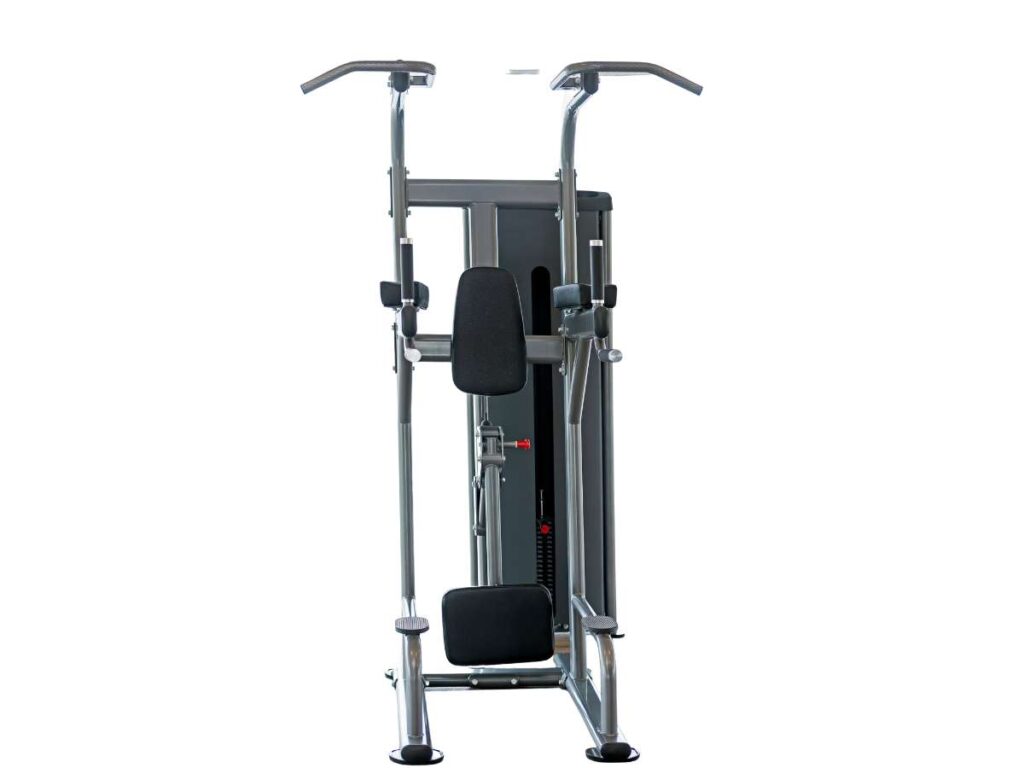
6. Functional Trainers
Functional trainers are one of those machines that surprise you.I added one in a corner of my gym, thinking it might just be a bonus piece. It became a main attraction.
A functional trainer is a cable-based machine with two adjustable pulleys. Users can move each arm up, down, or out to target muscles at almost any angle. It’s flexible, user-friendly, and great for full-body workouts.
From lat pulldowns to curls, chest presses to rotations—this machine handles a lot.
Specifications
Here’s what most commercial models offer:
- Pulley Range: Fully height adjustable
- Weight Stack: Dual 150–200 lb stacks
- Handles: D-handles included (other attachments optional)
- Frame: Heavy steel with wide stance for stability
- Dimensions: Around 60”–65” wide, 80”+ tall
- Cable Travel: Typically 70”–90” (long enough for most users)
Features
- Dual Adjustable Pulleys: Users can perform bilateral or single-arm movements for strength and balance.
- High Cable Travel Range: Gives plenty of room for lat pulldowns and overhead motions.
- Exercise Versatility: Over 50 possible movements, all in one footprint.
- Built-In Storage Hooks: Keeps extra attachments organized and off the floor.
- Smooth, Quiet Movement: Makes it easier for users to focus on form and flow.
Is This Worth the Investment?
If your gym needs a multi-use station in a single frame, this machine delivers.
You’ll gain:
- Full-body training options
- A low-risk machine for all fitness levels
- One of the most trainer-friendly tools available
Trainers in my gym love it. It’s their go-to for warmups, rehab, and customized workouts.
The downside? These machines demand a higher upfront investment, which could stretch the budget in smaller or startup facilities.
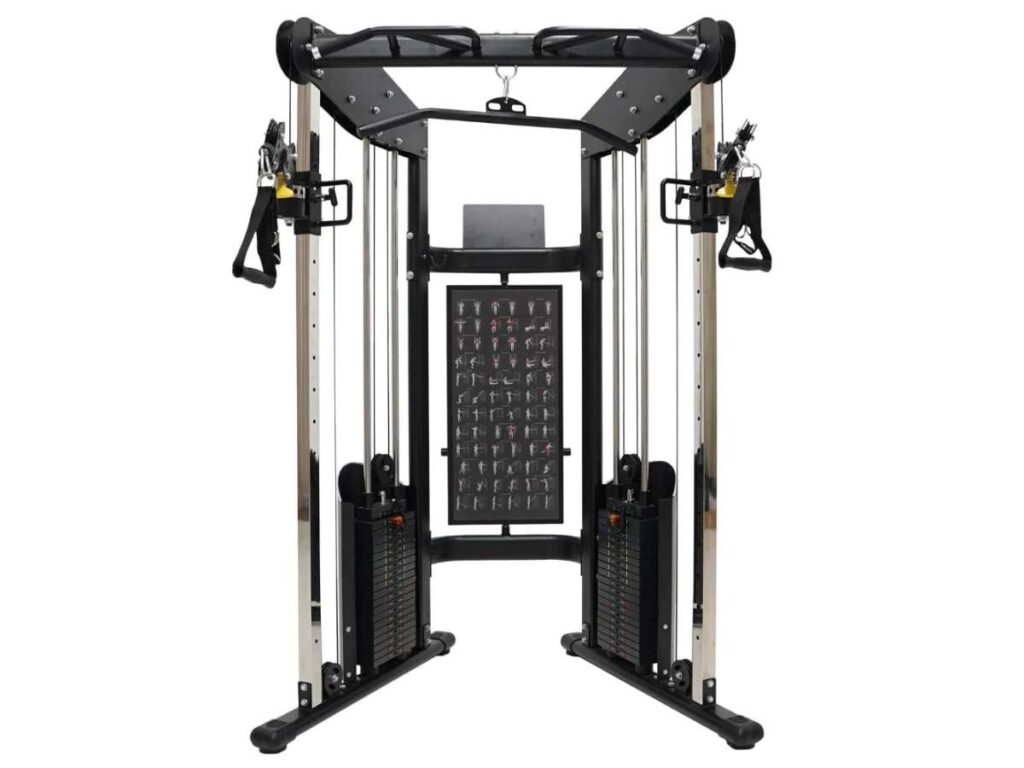
7. Smith Machine Lat Pulldowns
Using a lat pulldown attachment with a Smith machine lets you turn an existing setup into a multi-use station. You just attach a high pulley system to the top bar and load weight plates onto the carriage.
It’s a smart way to expand your training options without buying another full machine—perfect for those working from a lean small gym business plan.
Specifications
Typical Smith machine with lat attachment includes:
- Pulley System: High-mounted, plate-loaded
- Weight Capacity: 300–600 lbs (varies by brand)
- Cable Type: Steel or nylon, often coated
- Seat: Add-on or adjustable bench optional
- Footprint: Around 85” tall, 80” wide (varies by frame)
- Bar Compatibility: Standard Olympic bar
- Finish: Powder-coated steel frame
Features
- Multi-Use Setup: Combine barbell training and cable pulldowns in one station.
- Custom Weight Load: Add the exact plates you want—no fixed stack.
- Adjustable Bench Option: Add a flat or seated bench for more control.
- Simple Upgrade: Pulley kits are easy to attach and remove.
- Durability: Smith machines are built to handle regular, heavy use.
Is This Worth the Investment?
If you already own a Smith machine, adding a pulley system can be a cost-effective upgrade.
You’ll get:
- More use out of existing equipment
- Less floor space taken
- Flexible training options without a huge spend
This setup worked great in smaller studio. It helped offer cable work without cramming in another machine.
However, the movement range can feel restrictive, making it a less-than-ideal substitute for a dedicated lat pulldown station.
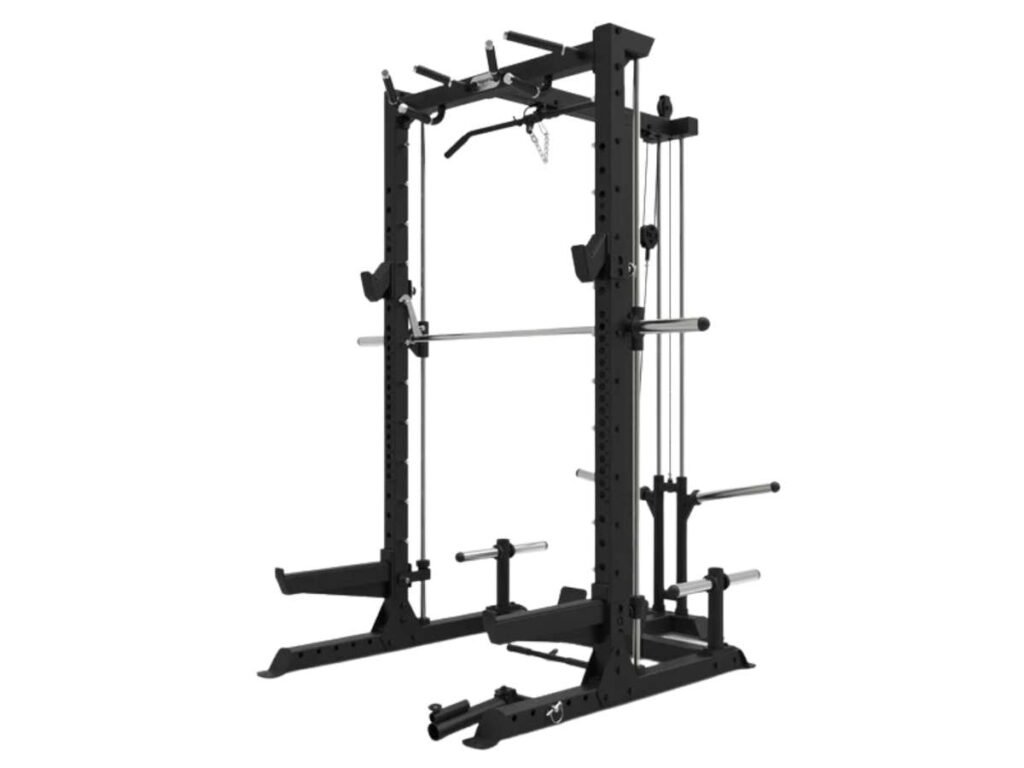
8. Smith Machine Upright Row
Smith machine for upright rows gives users more control and stability. It locks the bar path, which can help reduce shoulder strain and keep form tight—especially for newer lifters.
This move mainly targets the shoulders and traps. It’s simple but effective. And if your gym already has a Smith machine, it’s an easy add-on to your training mix.
Specifications
Here’s what you’ll typically work with:
- Bar Path: Fixed vertical or slightly angled
- Weight Load: Olympic plates (not selectorized)
- Frame: Powder-coated steel, 11–12 gauge
- Dimensions: Around 80” high, 80” wide
- Bar Weight: Usually 15–25 lbs (varies by brand)
- Safety Stops: Included for controlled lift range
Features
- Fixed Motion Path: Helps guide users through safer, more consistent upright rows.
- Adjustable Starting Height: Makes setup easier for different body types.
- Simple Plate Loading: Use your current plate supply—no stack required.
- Compact Design: Already part of most Smith stations, no extra floor space needed.
- Progressive Training: Easy to add small weight increases for steady progress.
Is This Worth the Investment?
If your gym already has a Smith machine, you’re not spending anything extra. Just teach proper form, and it becomes another great use of the same station.
You’ll get:
- Added shoulder training value
- Safer form for new users
- More programming variety without more equipment
I’ve seen members prefer this setup over free weights, especially when learning new movements.
But, the fixed bar path may not suit all body types, and repeated use could cause discomfort for members with shoulder limitations.
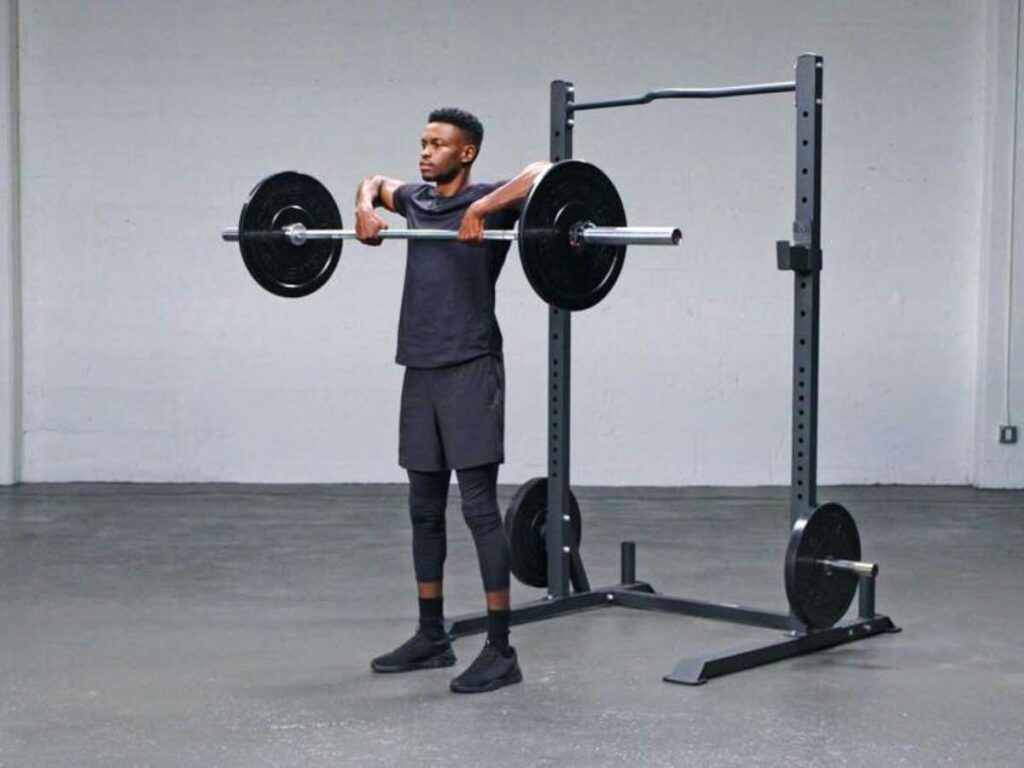
9. Wall-Mounted Lat Pulldown Machines
Space is one of the biggest challenges in smaller gyms. I know that struggle well.
Before I had the room for full racks and heavy stations, I had to get creative—something I learned while optimizing gym layout design for better space and functionality. That’s when wall-mounted equipment started catching my eye. A wall-mounted lat pulldown machine does exactly what the name says. It bolts to your wall, not the floor, and gives your members full pulldown functionality without eating up valuable space.
Specifications
Most commercial wall-mounted models include:
- Mounting Style: Direct-to-wall or wall + floor plate
- Pulley Type: High-mounted with cable system
- Weight Load: Plate-loaded or selectorized
- Frame Material: Heavy-gauge steel with anti-rust coating
- Dimensions: Roughly 24”–30” wide and 80”+ tall
- Seat: Optional fold-away or separate bench
Features
- Space-Saving Design: Mounts to the wall, leaving floor space open for other equipment.
- Solid Pulling Power: Same function as freestanding units, without the bulk.
- Multiple Weight Options: Comes in plate-loaded or selectorized, depending on your preference.
- Optional Seating: Add a bench or fixed seat based on how you want it used.
- Easy to Maintain: Fewer moving parts and cables make it simple to keep in shape.
Is This Worth the Investment?
For smaller gyms, PT studios, or even garage setups, yes—it makes a lot of sense.
You’ll get:
- High-function vertical pull capability
- No wasted floor space
- A clean, low-maintenance install
I added one to a corner wall in my PT room, and it’s been in daily use ever since. At YR Fitness, we offer a wide range of gym equipment, allowing you to choose the right option that fits your gym floor.
However, secure installation requires reinforced wall structures, which can add complexity and cost during setup or retrofits.
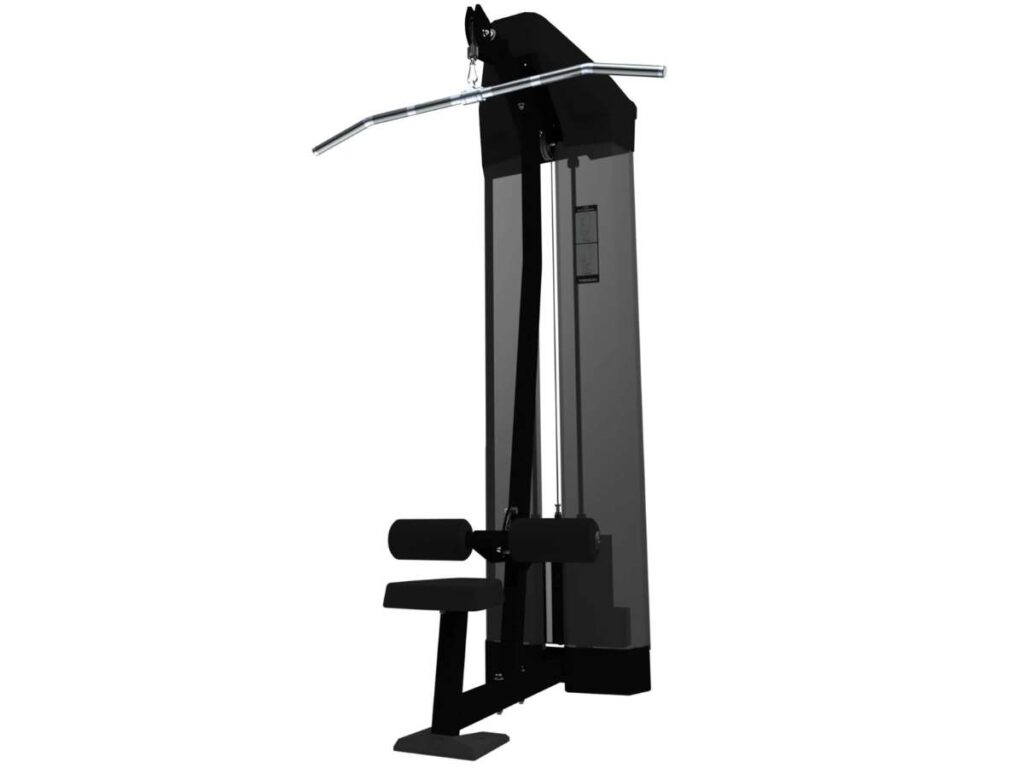
10. LAT Pull Down Machine Low Row
The lat pulldown machine with low row is a dual-function unit that combines two essential back exercises into one machine.
It features a high pulley for traditional lat pulldowns and a low pulley with a footplate for seated rows. This combination targets both upper and middle back muscles efficiently.
Designed for gyms that need to save space without losing functionality, this machine offers more training variety in a compact footprint.
Specifications
Most combo units offer:
- Pulley Setup: Dual—one high, one low
- Weight Type: Plate-loaded or selectorized
- Frame: 11-gauge steel, powder-coated
- Seat: Adjustable with thigh hold-downs
- Cable Type: High-tensile steel, coated
- Footplate: Angled row platform included
- Size: About 48” x 70”
Features
- Two-in-One Function: Perform both lat pulldowns and low rows without switching machines.
- Multiple Grip Options: Supports wide, narrow, and neutral grips for varied back training.
- Stable Frame: Built to handle heavy use in commercial settings.
- Easy Transitions: Switch from high to low pulley quickly during workouts.
- Compact Build: Saves space without cutting corners on performance.
Is This Worth the Investment?
For gyms short on floor space but high on traffic, yes—it’s a strong choice.
You’ll get:
- Versatility without extra equipment
- Better use of every square foot
- One station that meets two big training needs
I’ve placed this unit in small corners and had it running nonstop. But, shared components can limit member throughput during busy times, as users may need to wait to alternate between functions.
Conclusion
That first machine I bought? The one no one used?
I wish I had a guide like this back then. You’ve just explored 10 lat pulldown options—each with different strengths, sizes, and setups.
Now you know what fits where, why it matters, and how to choose what’s right for your gym.
So, what’s your next move?
Don’t let guesswork hold you back. Take action. Grow smarter. Build a gym people remember.
Contact YR Fitness today to find the right equipment for your floor and your members.
Related articles:





